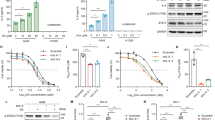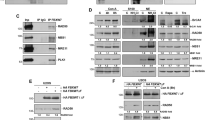Abstract
Recent findings have established caspase-2 as an important apical regulator in apoptotic pathways leading from DNA damage to release of mitochondrial cytochrome c and subsequent activation of effector caspases. Yet, the molecular map connecting the embarking stimuli of genotoxic stress with caspase-2 activation remains to be elucidated. Here, we address the question of potential caspase-2 regulators by examining 5-fluorouracil (5-FU)-induced apoptosis in wild-type and p53-deficient human colon carcinoma cells. Apoptosis was observed only in p53+/+ cells and was preceded by caspase-2 activation. Hence, although no direct interaction between p53 and caspase-2 was observed in the cell system used, our data clearly demonstrate that a functional connection between these two proteins is essential for initiation of the 5-FU-induced apoptotic process. Proposed mediators of caspase-2 activation include PIDDosome complex proteins PIDD and RAIDD. Surprisingly, the presence of a complex encompassing at least RAIDD, PIDD and caspase-2 was verified in both p53+/+ and p53−/− cells, also in the absence of 5-FU treatment. Thus, our results confirm the participation of PIDD and RAIDD in PIDDosome complex formation but question their role as sole mediators of caspase-2 activation. This assumption was further supported by siRNA transfections targeting PIDD or RAIDD. In conclusion, our findings support the hypothesis of p53 as an upstream regulator of caspase activity and provide data concerning caspase-2 processing mechanisms. As suppression of caspase-2 expression in 5-FU-treated cells also affects the level of the p53 protein, possibilities of a reciprocal interaction between these proteins are discussed.
This is a preview of subscription content, access via your institution
Access options
Subscribe to this journal
Receive 50 print issues and online access
$259.00 per year
only $5.18 per issue
Buy this article
- Purchase on Springer Link
- Instant access to full article PDF
Prices may be subject to local taxes which are calculated during checkout









Similar content being viewed by others
Abbreviations
- 5-FU:
-
5-fluorouracil
- DD:
-
death domain
- CARD:
-
caspase recruitment domain
- FACS:
-
fluorescence-activated cell sorting
- fmk:
-
fluoromethyl ketone
- PS:
-
phosphatidylserine
- PI:
-
propidium iodide
- DAPI:
-
4′,6-Diamidine-2′-phenylindole dihydrochloride
References
Baliga BC, Colussi PA, Read SH, Dias MM, Jans DA, Kumar S . (2003). J Biol Chem 278: 4899–4905.
Baliga BC, Read SH, Kumar S . (2004). Cell Death Differ 11: 1234–1241.
Bergeron L, Perez GI, Macdonald G, Shi L, Sun Y, Jurisicova A et al. (1998). Genes Dev 12: 1304–1314.
Berube C, Boucher LM, Ma W, Wakeham A, Salmena L, Hakem R et al. (2005). Proc Natl Acad Sci USA 102: 14314–14320.
Boatright KM, Salvesen GS . (2003). Curr Opin Cell Biol 15: 725–731.
Bunz F, Dutriaux A, Lengauer C, Waldman T, Zhou S, Brown JP et al. (1998). Science 282: 1497–1501.
Castedo M, Perfettini JL, Roumier T, Valent A, Raslova H, Yakushijin K et al. (2004). Oncogene 23: 4362–4370.
Ding HF, Lin YL, McGill G, Juo P, Zhu H, Blenis J et al. (2000). J Biol Chem 275: 38905–38911.
Enoksson M, Robertson JD, Gogvadze V, Bu P, Kropotov A, Zhivotovsky B et al. (2004). J Biol Chem 279: 49575–49578.
Fuentes-Prior P, Salvesen GS . (2004). Biochem J 384: 201–232.
Guo Y, Srinivasula SM, Druilhe A, Fernandes-Alnemri T, Alnemri ES . (2002). J Biol Chem 277: 13430–13437.
Harvey NL, Trapani JA, Fernandes-Alnemri T, Litwack G, Alnemri ES, Kumar S . (1996). Genes Cells 1: 673–685.
Ho PK, Jabbour AM, Ekert PG, Hawkins CJ . (2005). FEBS J 272: 1401–1414.
Janssens S, Tinel A, Lippens S, Tschopp J . (2005). Cell 123: 1079–1092.
Jiang M, Milner J . (2003). Genes Dev 17: 832–837.
Koseki T, Inohara N, Chen S, Nunez G . (1998). Proc Natl Acad Sci USA 95: 5156–5160.
Lassus P, Opitz-Araya X, Lazebnik Y . (2002). Science 297: 1352–1354.
Levav-Cohen Y, Goldberg Z, Zuckerman V, Grossman T, Haupt S, Haupt Y . (2005). Biochem Biophys Res Commun 331: 737–749.
Lin CF, Chen CL, Chang WT, Jan MS, Hsu LJ, Wu RH et al. (2005). J Biol Chem 280: 23758–23765.
Lin Y, Ma W, Benchimol S . (2000). Nat Genet 26: 122–127.
Mancini M, Machamer CE, Roy S, Nicholson DW, Thornberry NA, Casciola-Rosen LA et al. (2000). J Cell Biol 149: 603–612.
Marsden VS, Ekert PG, Van Delft M, Vaux DL, Adams JM, Strasser A . (2004). J Cell Biol 165: 775–780.
Miyashita T, Reed JC . (1995). Cell 80: 293–299.
Nakano K, Vousden KH . (2001). Mol Cell 7: 683–694.
Nicholson DW, Thornberry NA . (1997). Trends Biochem Sci 22: 299–306.
O'Reilly LA, Ekert P, Harvey N, Marsden V, Cullen L, Vaux DL et al. (2002). Cell Death Differ 9: 832–841.
Park HH, Wu H . (2006). J Mol Biol 357: 358–364.
Paroni G, Henderson C, Schneider C, Brancolini C . (2001).J Biol Chem 276: 21907–21915.
Ren J, Shi M, Liu R, Yang QH, Johnson T, Skarnes WC et al. (2005). Proc Natl Acad Sci USA 102: 565–570.
Robertson JD, Enoksson M, Suomela M, Zhivotovsky B, Orrenius S . (2002). J Biol Chem 277: 29803–29809.
Robertson JD, Gogvadze V, Kropotov A, Vakifahmetoglu H, Zhivotovsky B, Orrenius S . (2004). EMBO Rep 5: 643–648.
Rotter B, Kroviarski Y, Nicolas G, Dhermy D, Lecomte MC . (2004). Biochem J 378: 161–168.
Scholz C, Wieder T, Starck L, Essmann F, Schulze-Osthoff K, Dorken B et al. (2005). Oncogene 24: 1904–1913.
Schuler M, Bossy-Wetzel E, Goldstein JC, Fitzgerald P, Green DR . (2000). J Biol Chem 275: 7337–7342.
Schuler M, Green DR . (2005). Trends Genet 21: 182–187.
Seth R, Yang C, Kaushal V, Shah SV, Kaushal GP . (2005). J Biol Chem 280: 31230–31239.
Shearwin-Whyatt LM, Harvey NL, Kumar S . (2000). Cell Death Differ 7: 155–165.
Shikama Y, U M, Miyashita T, Yamada M . (2001). Exp Cell Res 264: 315–325.
Tang J, Xie W, Yang X . (2005). Cancer Biol Ther 4: 645–649.
Telliez JB, Bean KM, Lin LL . (2000). Biochim Biophys Acta 1478: 280–288.
Tinel A, Tschopp J . (2004). Science 304: 843–846.
Troy CM, Rabacchi SA, Hohl JB, Angelastro JM, Greene LA, Shelanski ML . (2001). J Neurosci 21: 5007–5016.
Wang Q, Maniati M, Jabado O, Pavlaki M, Troy CM, Greene LA et al. (2005). Cell Death Differ 13: 75–83.
Wieder T, Essmann F, Prokop A, Schmelz K, Schulze-Osthoff K, Beyaert R et al. (2001). Blood 97: 1378–1387.
Acknowledgements
We thank Dr Finbarr Murphy (EiRx, Ireland) for insightful discussions and help in development of siRNA technique, Dr Bert Vogelstein (The Johns Hopkins School of Medicine, Baltimore, USA) for providing HCT116 cells, Dr Jürg Tschopp (University of Lausanne, Switzerland) for anti-PIDD Abs and Dr Moshe Oren (Weizmann Institute of Sciences, Rehovot, Israel) for critical reading of the manuscript and valuable suggestions. This work was supported by grants from the Swedish Research Council (31X-02471-37A), the Swedish (3829-B04-09XAC) and Stockholm (041502) Cancer Societies, and the EC-RTD grant (QLK3-CT-2002-01956).
Author information
Authors and Affiliations
Corresponding author
Rights and permissions
About this article
Cite this article
Vakifahmetoglu, H., Olsson, M., Orrenius, S. et al. Functional connection between p53 and caspase-2 is essential for apoptosis induced by DNA damage. Oncogene 25, 5683–5692 (2006). https://doi.org/10.1038/sj.onc.1209569
Received:
Revised:
Accepted:
Published:
Issue Date:
DOI: https://doi.org/10.1038/sj.onc.1209569
Keywords
This article is cited by
-
Caspase-2: an orphan enzyme out of the shadows
Oncogene (2017)
-
Crocetin exploits p53-induced death domain (PIDD) and FAS-associated death domain (FADD) proteins to induce apoptosis in colorectal cancer
Scientific Reports (2016)
-
E1A enhances cellular sensitivity to DNA-damage-induced apoptosis through PIDD-dependent caspase-2 activation
Cell Death Discovery (2016)
-
Caspase-2: the reinvented enzyme
Oncogene (2015)
-
Molecular cloning of two molluscan caspases and gene functional analysis during Crassostrea angulata (Fujian oyster) larval metamorphosis
Molecular Biology Reports (2015)



